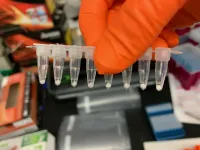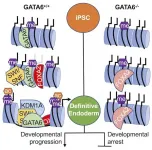(Press-News.org) In fighting the COVID-19 pandemic, it's not just the vaccines that require complicated cold supply chains and refrigerated storage. Polymerase chain reaction (PCR) tests -- often considered the "gold standard" of testing -- also have enzymes and reagents that need to be frozen.
Northwestern University researchers have discovered that commercially available PCR tests can withstand the freeze-drying process, making them shelf-stable for up to 30 days and 50 degrees Celsius (122 degrees Fahrenheit), without sacrificing sensitivity and accuracy.
The researchers found that the testing reagents could be pre-mixed with a standard preservative, freeze-dried and then distributed and stored at room temperatures. When the test is needed, health care workers then add water to rehydrate the test for immediate use.
The new strategy could help ease logistical challenges, making tests more available to help schools, businesses and sporting events safely reopen. It also could be a particularly powerful option for low-resource settings that lack access to reliable electricity and refrigeration.
"At different points in time, the COVID-19 pandemic nearly broke our health care system," said Northwestern's Michael Jewett, who led the study. "With our strategy, we can eliminate the need for cold-chain shipping and reduce labor costs needed for on-site mixing of diagnostic reagents. It would be extremely gratifying if this could allow testing to be developed and deployed much more broadly around the globe."
The research, which includes instructions health care and lab workers can use to start freeze-drying PCR tests immediately, was published June 10 in the Biotechnology Journal.
Jewett is a professor of chemical and biological engineering at Northwestern's McCormick School of Engineering and director of Northwestern's Center for Synthetic Biology. He also is a member of the Simpson Querrey Institute, Chemistry of Life Processes Institute and Robert H. Lurie Comprehensive Cancer Center of Northwestern University.
The same process used to make astronaut ice cream, freeze drying extends the shelf-life of perishable materials by freezing them and then dehydrating them by removing the ice. Earlier this year, Jewett led studies to develop shelf-stable vaccines with freeze-dried components. Now, his team uses a similar philosophy to help expand access to gold-standard testing.
"The pandemic has highlighted the challenges and limitations of centralized laboratory testing," Jewett said. "Testing relies on trained personnel with a significant amount of expertise, expensive equipment and complicated logistics that require a stable cold chain. There is a pressing need for testing strategies that are easy to use, reduce labor at the point-of-care and are inexpensive to deploy anywhere in the world."
In their new study, Jewett and his team bought five PCR kits directly from vendors. After fully assembling the reactions, they added simple preservatives to stabilize the mix and then stored the tests at varying lengths, conditions and temperatures.
"We needed to make sure the tests still worked in the presence of the preservatives," Jewett said. "PCR kits are based on proteins, which can fall apart when exposed to elevated temperatures or oxygen, so we have to keep them cold. If we add a preservative, it stabilizes the proteins to keep them from falling apart. But we also needed to make sure the preservative didn't interfere with the biological machinery in the test."
Of the mixes tested, the researchers showed that one commercial test maintained activity and sensitivity after storage for 30 days at both ambient and elevated temperatures. With this strategy, tests can be distributed and stored as a dry powder at room temperature and rehydrated on-demand.
"We could stockpile these tests and distribute them without a cold chain," Jewett said. "And that's the important thing. It's now an all-in-one kit -- no longer multiple parts that need to be mixed together in a cocktail. It's one test that's freeze-dried and activated with water."
The paper is titled "Lyophilization of premixed COVID-19 diagnostic RT-qPCR reactions enables stable long-term storage at elevated temperatures."
INFORMATION:
In 2007, the American housing boom ended, and there was heightened risk of a housing crisis. Private securitizers withdrew from purchasing high-risk mortgages, while government-sponsored enterprises, Fannie Mae and Freddie Mac, dramatically increased their acquisitions of risky mortgages. By 2008, the agencies reversed course, decreasing their high-risk acquisitions.
In a new article, an economist proposes a scenario in which large lenders temporarily boost high-risk activity at the end of a boom. According to her model, lenders with many outstanding mortgages have incentives to extend risky credit to prop up housing prices, which lessens the losses on their outstanding portfolio of mortgages. As the bust continues, lenders slowly wind down their mortgage exposure.
The ...
BOSTON - The cost of cancer care in United States was an estimated $183 billion in 2015 and is projected to rise by 30 percent by 2030, according to the American Cancer Society. While private and government insurance may cover much of the cost of care, even patients with insurance can struggle to pay for office visit co-payments, prescription medications or other cancer-related expenses. Yet limited data describes how financial hardship impacts patient behavior and how that in turn may impact patient health.
In a new study designed to provide a more comprehensive picture of how a diverse cohort of gynecologic cancer patients are affected by financial distress -- also called "financial toxicity" in acknowledgment of the health ...
RIVERSIDE, Calif. -- When two similar atomic layers with mismatching lattice constants -- the constant distance between a layer's unit cells -- and/or orientation are stacked together, the resulting bilayer can exhibit a moiré pattern and form a moiré superlattice.
Moiré patterns are interference patterns that typically arise when one object with a repetitive pattern is placed over another with a similar pattern. Moiré superlattices, formed by atomic layers, can exhibit fascinating phenomena not found in the individual layers, opening the door to technological revolutions in many areas, including electricity transmission, information engineering, and ...
White men who had a Black neighbor when they were growing up are more likely to be Democrats and less likely to be Republican, an influence that can last several decades later.
That's according to a Harvard study published Friday in Science Advances that takes individual level data from 650,000 Americans recorded in the 1940 U.S. Census. Using machine learning, the analysis links those records to contemporary voter files to see if there are correlations between having a Black neighbor as a child and political views later in life. The paper includes only men because the common practice of surname changes at marriage made it difficult to accurately track women.
The scientists found that those 650,000 white men who had a Black neighbor growing up are believed to be more likely ...
There is no question that the pandemic has been immensely stressful for health care workers, especially for those on the frontline of patient care. Yet, even before the pandemic, the regular demands of many health care industry jobs put these workers at risk for burnout.
Now, a new study from the University of Georgia suggests that investing in more physical activity programming could mitigate the effects of stress and improve worker mental and emotional health.
Tackling burnout in health care is critical to ensuring patient safety, said lead author Marilyn ...
(Boston)-- Prevalence rates of opioid use disorder (OUD) have increased dramatically, accompanied by a surge of overdose deaths--nearly 50,000 in the U.S. in 2019. While opioid dependence has been extensively studied in preclinical models, an understanding of the biological alterations that occur in the brains of people who chronically use opioids and who are diagnosed with OUD remains limited.
To address this issue, researchers from Boston University School of Medicine (BUSM) have conducted the largest transcriptomic (the study of all the RNA molecules within a cell) study to date using postmortem ...
People with end-stage renal disease often undergo hemodialysis, a life-sustaining blood-filtering treatment. To make the process as fast and efficient as possible, many people have "hemodialysis grafts" surgically implanted. These grafts are like bypasses, connecting a vein to a major artery, making it easier to access blood and ensuring the same blood doesn't get filtered twice.
But the grafts have a notorious problem: Clots tend to form where the graft is attached to the vein. For the person undergoing dialysis, this means not only a break from treatment, but also surgery to remove the graft and then surgery to implant another.
A multidisciplinary team from Washington University School of Medicine ...
Scientists know that developing cells in a healthy embryo will transform into a variety of cell types that will make up the different organ systems in the human body, a process known as cell differentiation. But they don't know how the cells do it.
A Medical University of South Carolina (MUSC) study in Cell Reports led by Stephen Duncan, D.Phil., examines how an endodermal cell - a type of developing cell - becomes a liver cell and not some other type of cell. Duncan and his team found that the development of naive cells into differentiated liver cells ...
Researchers have developed a new approach to gene therapy that leans on the common pain reliever acetaminophen to force a variety of genetic diseases into remission.
A paper published in Science Translational Medicine describes how the novel technique successfully treated the blood-clotting disorder hemophilia and the debilitating metabolic disease known as phenylketonuria, or PKU, in mice.
The approach uses a benign lentivirus to both correct disease-causing mutations and to insert a new gene that makes liver cells immune to the potentially toxic effects of acetaminophen. The latter ...
CINCINNATI--The disease is so rare and complex that its acronym is hard to pronounce. But for infants unlucky enough to be born with this lung disease, the outcome is usually fatal.
The disease is called alveolar capillary dysplasia with misalignment of the pulmonary veins (ACDMPV). Research indicates the disease is linked to mutations in the FOXF1 gene. Worldwide, medical experts have documented about 200 cases, but an unknown number of infants may have died without the condition ever being diagnosed, according to the National Organization for Rare Disorders.
The disease is caused by genetic variations that prevent proper blood vessel formation in the lungs. Within ...




